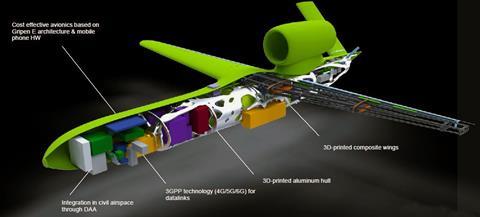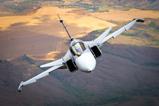Saab has revealed the first details about its Future Fighter System (KFS) study launched in mid-2023 for the Swedish armed forces.
Working in partnership with the nation’s air force, Defence Materiel Administration and the Swedish Defence Research Agency, Saab is under contract through the end of 2025, with discussions on the activity’s following phase due to start soon.
While Stockholm had been involved in early engagement with the UK on its future combat air system plans, Peter Nilsson, head of Saab Aeronautics’ advanced programmes business unit, says: “Sweden decided with all the things happening – the war in Ukraine, NATO membership, and a raised defence budget – let’s take a deep breath and see where we are going to go”.
Due to run until 2030, Nilsson describes the KFS effort as a “high-paced programme”.

“We are looking into concepts and technology demonstrators,” he says. Aspects to be explored include low observability and structures, internal weapons bays, autonomy and artificial intelligence (AI).
A wide array of platform types are being looked at, ranging from advanced manned designs to “loyal wingman”-type unmanned systems. Saab already has conducted windtunnel tests on some of the concepts to support early assessments.
The airframer stresses that an unmanned aircraft depicted alongside its Gripen E in one released image “is just an artist’s impression out of one of many concepts Saab is right now looking into together with the customer”.
A future concept evaluation review with the customer will cover “what would you like us to show in a demonstrator”, Nilsson says, with work also to include the use of simulation and ground test rigs.
Given the programme’s ambitious timeline and with Saab’s Gripen E only due to begin entering Swedish air force service next year, a potential focus could be on an unmanned platform such as a so-called collaborative combat aircraft.
Referring to Saab’s head of Gripen, Johan Segertoft, Nilsson hints: “It would be a shame not to use Johan’s platform” in support of future technology experiments, for example involving AI. “It’s built for this,” he said at the company’s Linkoping site on 20 May. “These are probably things that are going to end up in the E programme.”
The advanced programmes unit currently has around 120 staff, with this number set to rise to 270. “Right now in aeronautics I have 150 research and technology projects,” Nilsson notes. “And I have the sensor and EW [electronic warfare] guys inside my company.”
It also is exploring supporting technologies, such as a technique where transmit/receive modules for an active electronically scanned array (AESA) radar could be embedded within a honeycomb-type composite material.
“We are working new AESA technology, with the sensor becoming the structure – and not just in the nose,” Nilsson says.
Separately, Saab’s The Rainforest technology accelerator start-up plans to fly its ‘Ruby’ unmanned air vehicle at the Vidsel test range in northern Sweden later this year.

With a 3D-printed hull and 6-7m (19-23ft)-span composite wing, it will be powered by a GE Aerospace J85 engine sourced from a Saab 105 jet trainer.
“We are really pushing technology here,” Nilsson says, with the aircraft’s developers eyeing it for applications such as supporting wildfire monitoring work.


































